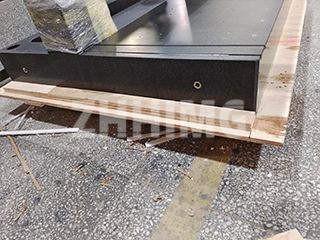Granite precision surface plates are essential tools in metrology, machining, and quality control. Their stability, flatness, and resistance to wear make them the preferred foundation for high-accuracy measuring instruments. However, one critical factor often overlooked during the purchasing process is load capacity. Selecting the proper load specification according to the weight of the measuring equipment ensures long-term accuracy, safety, and durability of the surface plate.
In this article, we explore how equipment weight influences surface plate performance, the importance of proper load selection, and practical guidelines for buyers in different industries.
Why Load Capacity Matters
Granite is known for its rigidity and minimal thermal expansion, but like all materials, it has a structural limit. Overloading a granite surface plate can cause:
-
Permanent deformation: Excessive weight may cause slight bending that alters flatness.
-
Measurement errors: Even microns of deviation can reduce accuracy in high-precision industries.
-
Reduced lifespan: Continuous stress shortens the working life of the plate.
Thus, understanding load capacity is not just about safety, but about preserving measurement reliability over time.
Factors That Influence Load Selection
-
Weight of the Measuring Equipment
The first and most obvious factor is the equipment weight. A small microscope may only require a light-duty surface plate, while a large coordinate measuring machine (CMM) can weigh several tons, demanding a reinforced platform. -
Distribution of Weight
Equipment with evenly distributed weight across the plate is less demanding than one that applies force at a concentrated point. For example, a CMM distributes weight through multiple legs, while a heavy fixture placed at the center creates higher localized stress. -
Dynamic Loads
Some machines involve moving parts that generate shifting loads and vibrations. In such cases, the granite plate must not only support static weight but also withstand dynamic stress without compromising flatness. -
Support Structure
The stand or support frame is part of the system. A poorly designed support can lead to uneven stress on the granite, regardless of its inherent strength. Buyers should always ensure that the support structure matches the plate’s intended load capacity.
Standard Load Capacity Guidelines
While specific values may vary depending on the manufacturer, most granite surface plates are categorized into three general load classes:
-
Light Duty (up to 300 kg/m²): Suitable for microscopes, calipers, small measuring instruments.
-
Medium Duty (300–800 kg/m²): Commonly used for general inspection, moderate machinery, or tool setups.
-
Heavy Duty (800–1500+ kg/m²): Designed for large equipment like CMMs, CNC machines, and industrial inspection systems.
It is recommended to select a surface plate with at least 20–30% higher capacity than the actual equipment weight, to provide a margin for safety and additional accessories.
Case Example: Choosing for a Coordinate Measuring Machine (CMM)
Imagine a CMM weighing 2,000 kg. If the machine distributes weight across four support points, each corner carries about 500 kg. A medium-duty granite plate might handle this under ideal conditions, but due to vibration and localized loads, a heavy-duty specification would be a more reliable choice. This ensures the plate remains stable for years without compromising measurement precision.
Practical Tips for Buyers
-
Request load charts from suppliers to verify specifications.
-
Consider future upgrades—choose a higher load class if you plan to use heavier equipment later.
-
Inspect support design—the base frame should complement the granite plate to prevent uneven stress.
-
Avoid localized overloads by using load-spreading accessories when placing heavy tools or fixtures.
-
Consult manufacturers for custom solutions when equipment weight falls outside standard categories.
Maintenance and Long-Term Stability
Even when the right load capacity is chosen, regular maintenance is essential to preserve flatness:
-
Keep the surface clean and free from dust or oil.
-
Avoid sudden impacts or dropping tools on the plate.
-
Periodically check flatness through calibration services.
-
Ensure the working environment is dry and temperature-controlled.
By following these guidelines, granite plates can maintain their precision for decades, even under heavy-duty conditions.
Conclusion
When purchasing a granite precision surface plate, load capacity should be a primary consideration alongside size and accuracy grade. Matching the plate’s specification to the equipment weight not only prevents deformation but also safeguards the accuracy of every measurement taken.
For industries relying on high-precision results—such as aerospace, semiconductor, and automotive manufacturing—investing in the right load capacity ensures long-term stability, cost savings, and measurement reliability.
Post time: Sep-25-2025

